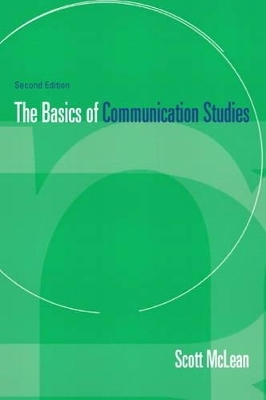
Basics of Communication Studies Plus MySearchLab with eText -- Access Card Package
Pearson
978-0-205-84428-9 (ISBN)
- Titel ist leider vergriffen;
keine Neuauflage - Artikel merken
Packages
Access codes for Pearson's MyLab & Mastering products may not be included when purchasing or renting from companies other than Pearson; check with the seller before completing your purchase.
Used or rental books
If you rent or purchase a used book with an access code, the access code may have been redeemed previously and you may have to purchase a new access code.
Access codes
Access codes that are purchased from sellers other than Pearson carry a higher risk of being either the wrong ISBN or a previously redeemed code. Check with the seller prior to purchase.
--Updated in this 2nd edition, The Basics of Communication Studies, introduces students to human communication in a clear, concise, and engaging way. It presents the “nuts and bolts” of human communication without excessive detail, delivering the necessary material on communication without being overwhelming or cost-prohibitive.
Most chapters begin with “Introductory Exercises” and conclude with “Summary,” “For More Information,” “Review Questions,” and “Works Cited.”
1. Why Study Communication?
Definition of Communication
Models of Communication
Essential Parts of Communication
Communication in Context
Principles of Communication
2. Perception and Listening
Introductory Exercises
Why Don't We All See Things the Same Way?
Perception and Awareness
Perceptual Differences
Self-Concept
Eyes, Ears, Heart
Importance of Listening
Kinds of Listening
Barriers to Listening
Improving Listening Skills
3. Verbal Communication
What Is Language?
Principles of Verbal Communication
Language as an Obstacle to Communication
Barriers to Communication
Improving Verbal Communication
4. Nonverbal Communication
What is Nonverbal Communication?
Principles of Nonverbal Communication
Types of Nonverbal Communication
Improving Your Understanding
5. Intercultural Communication
Definition of Intercultural Communication
Characteristics of Intercultural Communication
Barriers to Intercultural Communication
Improving Intercultural Communication
6. Intrapersonal and Interpersonal Communication.
What Is Intrapersonal Communication?
Maslow's Hierarchy
Schutz's Interpersonal Needs
Johari Window
Social Penetration Theory
Coming Together
Growing Apart
Improving Interpersonal Communication
7. Group Communication.
Types of Groups
How Groups Meet Our Basic Needs
How Many Members Does it Take to Make a Group?
Groups Play By Their Own Rules
Problem-Solving in Groups
How Do Groups Develop?
Lifecycles of Groups
Why Do People Stay in a Group?
Group Members Have Roles to Play
When Groups Come Together via Computers
Group Members as Leaders
8. Communication at Work
What Do You Know Already?
What Do You Need to Know?
Making Contact
You've Got the Invitation to Interview!
Effective Communication in Teams and Groups
Effective Communication in Meetings
Effective Communication in Virtual Meetings
9. Mass Communication
What Is Mass Communication?
Types of Mass Communication
Functions of Mass Communication
Effects of Mass Communication
Critical Analysis of Mass Communication
10. Speech Preparation
How to Choose a Topic
Getting to Know Your Audience
Conducting Research
The Five Parts of any Speech
Constructing the Introduction, Conclusion, and Effective Transitions
17 Organizational Patterns for your Speech
The Speech to Inform
Sample Outline: The Informative Speech
The Speech to Persuade
Sample Outline: The Persuasive Speech
Persuasive Arguments
Fallacies in Reasoning
Ethics in Communication
11. Speech Presentation
What Makes for a “Good Delivery?”
Speaking Effectively
Speech Anxiety
Nonverbal Communication and Delivery
Umms, Ahhs, and Other Speech Disfluencies
Effective Notecards and Other Useful Tools
Effective Eye Contact
Visual Aids: Purpose, Emphasis, Support, and Clarity
Types of Visual Aids
Methods and Materials
Preparing Visual Aids
Using Visual Aids
Effective PowerPoint Presentations
Index
| Erscheint lt. Verlag | 18.12.2011 |
|---|---|
| Sprache | englisch |
| Gewicht | 318 g |
| Themenwelt | Kunst / Musik / Theater ► Theater / Ballett |
| Sachbuch/Ratgeber ► Sport ► Tanzen / Tanzsport | |
| Schulbuch / Wörterbuch | |
| ISBN-10 | 0-205-84428-6 / 0205844286 |
| ISBN-13 | 978-0-205-84428-9 / 9780205844289 |
| Zustand | Neuware |
| Haben Sie eine Frage zum Produkt? |